Panasonic Lumix DMC-FZ1000 Review
Panasonic Lumix DMC-FZ1000 Introduction
The Panasonic Lumix DMC-FZ1000 is a bridge camera which features the largest sensor ever for an ultra-zoom. It is a 20 megapixels 1" CMOS sensor with high-speed read-out capture full-resolution images at 12 FPS and 4K Ultra-HD video at 30 FPS. This sensor is paired with a bright F/2.8-4 stabilized 16X optical zoom lens equivalent to 25-400mm.
This is a prosumer camera with full-manual controls, including manual-focus, white-balance fine-tuning, custom-white-balance, auto exposure bracketing, spot metering and many more features. The FZ1000 is shaped like an entry-level DSLR. It has an ultra-sharp 2.4 MP 0.39" EVF with Eye-Start sensor and a large 3" rotating touchscreen LCD.
The Panasonic FZ1000 is currently the only ultra-zoom to capture 4K video and it adds a number of derivative features such as continuously buffering 12 MP images at 30 FPS to catch fleeting moments, called 4K Photo Mode.
This digital camera review analyses the usability, performance and image quality of the Panasonic Lumix DMC-FZ1000.
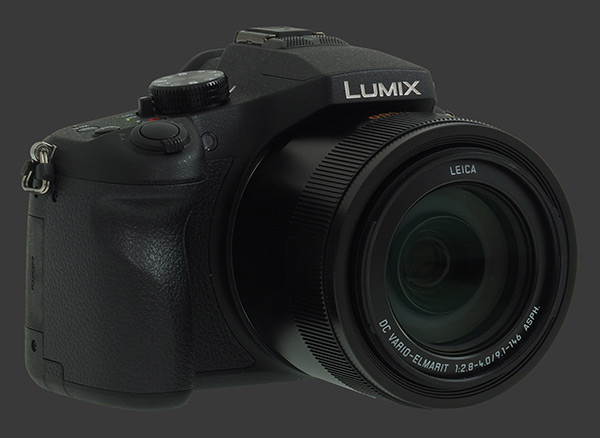
Panasonic Lumix DMC-FZ1000 Features
Sensor & Exposure
- 20 Megapixels 1" CMOS sensor
- Standard ISO 125-12800 range
- Expanded ISO 80-25600 range
- Auto ISO based on light-levels or movement
- 1/4000-60s Mechanical shutter-speeds
- 1/16000-1s Electronic shutter-speeds
- PASM Exposure modes, Program-Shift in P mode and Bulb, maximum 2 mins
- Exposure-Compensation, ±3 in 1/3 EV increments
- Multi-Segment, Average and Spot metering
- Built-in HDR, optional Auto-Align
- Multiple Exposure, 2-4 frames
Lens
- 16X Stabilized optical zoom
- F/2.8 / 4 Maximum aperture
- F/8 Minimum aperture for images
- F/11 Minimum aperture for videos
- Wide-Angle 25-400mm equivalent
- 3cm (W) - 1m (T) Minimum focus distance
Image Parameters
- Automatic, 5 presetsDaylight, Cloudy, Shade, Flash, Incandescent, Kelvin and custom white-balance, 2 memories
- WB fine-tuning, 19 steps along 2 axis
- WB Bracketing, 3 frames, 3 step size along A-B or G-M axis
- Standard, Vivid, Natural, Monochrome, Scenery & Portrait Photo Styles
- Adjustable Contrast, Sharpness, Saturation, Noise-Reduction, 11 steps each
- Adjustable Shadow and Hightlight tone-curve, 11 steps each
- JPEG Image, RAW Data or JPEG+RAW capture
- Optional Long-Shutter Noise-Reduction
Focus
- AF-S, AF-C, DMF and MF modes
- Pinpoint, Single-Area, Multi-Area, 49-Area, Tracking and Face-Detect focus-point selection
- Optional Eye-Start and stability prefocus
- Optional Manual Focus assist
- Optional Focus-Peaking
- Optional AF Assist-Lamp
Drive
- Single-Shot
- 12 FPS Drive w/o preview, Max 24 frames
- 7 FPS Drive w/ preview, Max 84 frames, AF-C
- 50 FPS Drive @ 5 MP w/o preview, Max 60 frames
- 4K 30 FPS Drive with continuous buffering
- Bracketing, 7 Frames, ±1 in 1/3 EV increments
- Self-Timer, 2s, 10s or 3-shot @ 10s
- Time-Lapse, 1s-99m59s interval, 1-9999 frames, 0-23h59m start delay
Display & Viewfinder
- 3" Rotating touchscreen LCD, 920K Pixels
- 0.39" EVF with Eye-Start sensor, 2.4 MP
- 100% Coverage, 0.7X Magnification
- Adjustable LCD Contrast/Saturation, 13 steps
- Adjustable LCD Tint, 21 stops along Red-Green or Blue-Yellow axis
- Optional Live-Histogram
- Optional Framing-Grids
Video
- 3840x2160 @ 30 FPS from center-crop
- 1920 x 1080 @ 60 FPS
- 1280 x 720 @ 30 FPS
- 640 x 480 @ 30 FPS
- MPEG-4 & AVCHD Codecs
- AF-S or AF-C focus
- Built-in stereo microphone
- -12..+6 dB Audio adjustment
- Optional Zoom Microphone
- Optional Wind-Filter
Flash
- Flash Compensation, ±3 EV, 1/3 EV increments
- Auto, Auto Redeye, Forced, Redeye & Slow-Sync flash modes
- First or Rear curtain flash sync
- Manual Flash, 1/128-1 power
- Optional Redeye reduction
- Standard Hot-Shoe
Connectivity
- Stereo input mini-jack
- Wired remote connector
- HDMI (4K Ultra-HD) output
- A/V (NTSC / PAL) output
- USB 2.0 connectivity
Misc
- 4:3 (Native), 3:2, 16:9 & 1:1 Aspect-Ratio
- Fly-by-wire lens control-ring, focus or zoom
- Rear control-dial, clickable
- Customizable AE-L/AF-L
- 5 Customizable buttons
- 25 Scene Modes
- Sweep Panorama
- Optional Face-Recognition
- Lithium-Ion battery
- SDXC memory
Panasonic Lumix DMC-FZ1000 Usability - How easy is it to use?
This ultra-zoom is similar in size and shaped to a DSLR with a bright standard zoom attached. It provides a deep hand-grip, a broad lens barrel, large viewfinder with Eye-Start sensor and a popup flash. The hump housing the flash is flatter than on a DSLR and protrudes nicely from the back for to keep the photographer from pressing against the camera too much.
At the top of the hand-grip, there is a standard two-stage shutter-release with a soft halfway point. The FZ1000 has a variable-speed zoom-controller wrapped around the release. Twisting is more makes the lens zoom in faster. The lens moves in extremely fine steps, making it possible to zoom to any whole millimeter focal-length from 25 to 400mm.
Behind the shutter-release is a dedicated Video Record button. Pressing it starts and stops filming almost instantly. Using this button, video can be recorded in any exposure-mode with two important caveats:
- Video exposure remains automatic in all modes except for Manual Video, as explained further.
- The EVF and LCD only preview the correct framing for video in Manual Video mode.
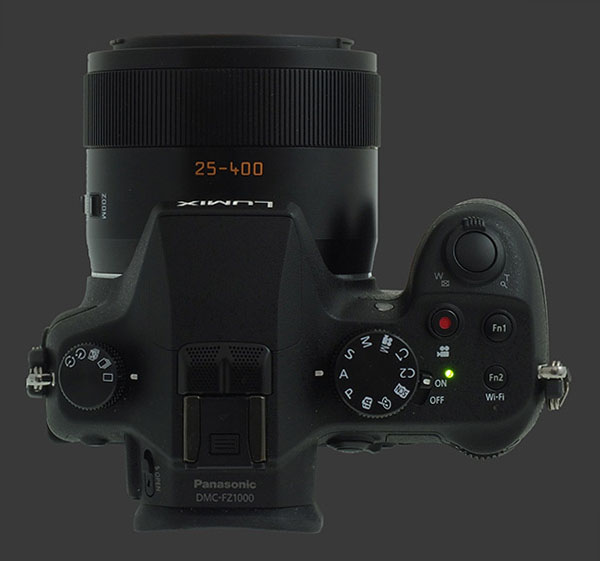
Next to the Video Record button, there is customizable button labelled Fn1. There are a whopping 44 options to from in Capture mode and 4 in Playback mode. Behind that one, there is a second customizable button, appropriately labelled Fn2. It defaults to activating WiFi and can be set to the same options as Fn1.
The FZ1000 features a mode-dial with 10 positions. The standard PASM exposure modes are all there, plus iA which is a fully automatic mode. There is an Effect mode and a SCN position that accesses 25 Scene modes, including Sweep Panorama. Two positions are for Custom modes. The first one accesses a single bank of settings, while the second offers three banks to choose from.
The final mode on the mode dial is Manual Movie mode. In this mode the Panasonic FZ1000 can record video using any PASM exposure mode, as selected in the Movie menu. While video could be recorded in other modes, this is the only way to capture 4K Ultra-HD which is only possible if the MPEG-4 codec is selected. 4K is available at 30 and 24 FPS. 1080p HD is also available at 60 or 30 FPS. 720p and VGA only support 30 FPS.
An AVCHD codec is also available. With it, one can record 1080p at 60 FPS, either progressive or interlaced, or 24 FPS progressive. In Manual Movie mode, both the shutter-release and the dedicated Video Record button start filming.
Just under the mode-dial is a simple power switch with strong detents. This digital camera remembers settings with the option of resetting EC when the mode is changed or camera is powered off. Optionally, it can remember the zoom position too which is very useful for repeating shots.
On the left shoulder of the FZ1000, there is Drive Mode dial. It offers 5 positions, most of them adjustable further via the Quick Menu. Continuous Drive offers 2, 7, 12 and 50 FPS. This last one is limited to 5 MP but the rest are possible at full-resolution. Speeds above 7 FPS are not previewed which makes following moving subjects impossible. AEB can take 3, 5 or 7 shots with up to 1 EV increments, in 1/3 steps. Three Self-Timers are available, 2s, 10s or triple-shot at 10s.
The Interval Timer on this prosumer camera is extremely flexible. Intervals of 1 second to 99 minutes and 59 seconds are possible which can be repeated up to 9999 times. The start can be immediate or up to 23 hours and 59 minutes later. Uniquely, the sequence can be paused between frames which is extremely useful should an obstacle temporarily block the camera for instance. When the time-lapse is complete, the FZ1000 can create a video at any supported video-resolution, up to 4K Ultra-HD at 30 FPS.
The last remaining items on the top plate are a popup flash, hot-shoe and stereo microphone. The microphone includes a built-in wind-filter which is activated from the Motion Picture menu. This stereo microphone has been designed to optionally zoom with the lens in an attempt to better record what is being filmed.
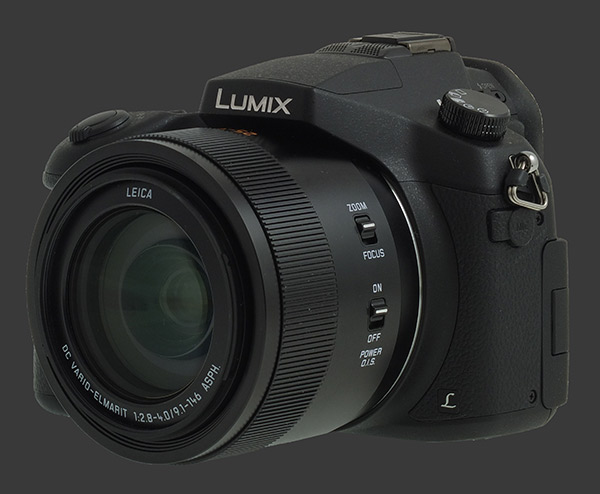
There is a wide fly-by-wire lens control-ring which can be used to zoom at medium-speed or adjust the focus-distance. It rotates smoothly and continuously with almost immediate feedback on the EVF and LCD. A simple switch on the lens barrel selects between zooming and focusing. Focusing will not operate if the camera is not in MF or AF+MF (DMF) mode though.
The lens barrel has a second switch to enable optical image stabilization. A menu option controls if stabilization is applied for all movements or only for vertical ones. The latter option helps produce smoother panning shots where the camera is deliberately moved horizontally during an exposure.
On the same side as the lens switches, there is a flexible rubber flap which covers a 3.5mm mini-jack to plug in an external microphone. One can also see the LCD hinge above which lets the screen flip outwards all the way until it faces the front. It can then rotate vertically. While this is flexible, it also makes shooting at odd angles rather cumbersome and more difficult to stay level.
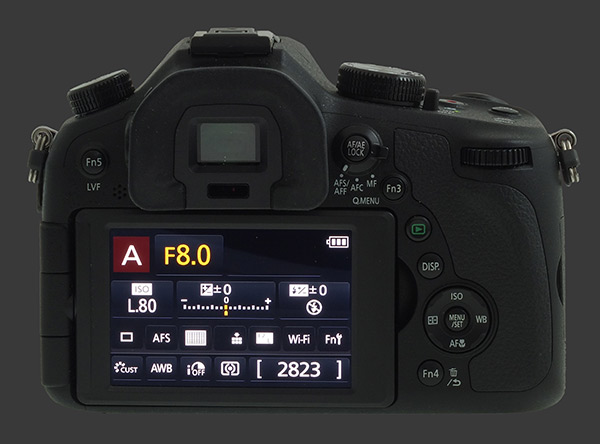
The back of the camera is dominated by a large 3" LCD with 920K pixels. Visibility of the LCD is superb with an good anti-reflective coating that does its job very well. Angle-of-view is also very good, showing a minor loss of contrast when not directly facing the LCD.
The view on the LCD and EVF is not Exposure-Priority until the shutter is press halfway. When pressed halfway, the preview is mostly correct, providing a good approximation of exposure. There is a note in the manual saying that the Live-Histogram turns yellow when the displayed image does not show the correct brightness. Since the displays are not Exposure-Priority, it turns yellow as soon as an EC is dialed-in! Also, it is far more often wrong than right. The issue is that it is based on the displayed brightness and not the metered one. This means that when the shutter is pressed halfway, the live-histogram frequently adjusts itself.
A 2.4 megapixels 0.39" EVF with Eye-Start sensor is located above the LCD. This viewfinder is large with a 0.7X magnification and shows precisely 100% coverage. Its resolution is superb and is sufficient to confirm focus without additional magnification. The Eye-Start sensor sensitivity is perfect and the view automatically switches between the EVF and LCD quickly.
To the left of the EVF, there is a customizable Fn5 button. By default, it cycles over EVF, LCD or Eye-Start mode. To the right, there is a customizable AE-L/AF-L button surrounded by a 3-position focus-switch. AE-L/AF-L can be configured to lock exposure, focus, both of these or perform autofocus (AF-On). The switch around it selects between AF-S/AF-F, AF-C or MF. A menu option decides if the first position is for Single-Shot (AF-S) or Auto Switching (AF-F) autofocus.
Right next to the upper corner of the LCD frame, there is yet another customizable button, Fn3. This one defaults to showing the Quick Menu which itself is customizable. This is a graphic menu used to access frequently-used settings. It can be easily navigated using the clickable control-dial. The 4-way controller can be used instead, just not as efficiently.
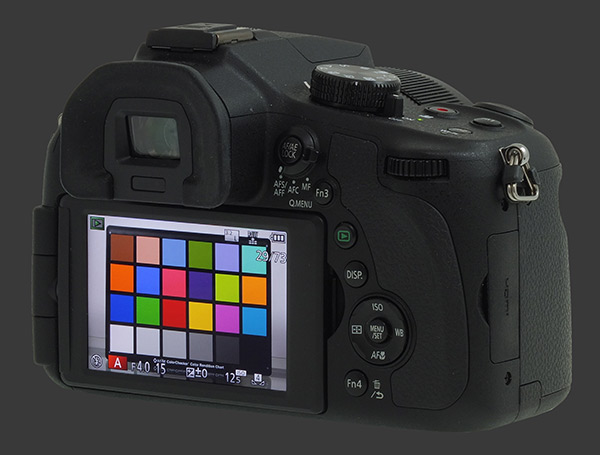
The Panasonic Lumix DMC-FZ1000 has a single control-dial to set exposure parameters. The dial doubles as a button to cycle between parameters and EC as needed. In Program mode, it cycles between EC and Program-Shift. In Aperture-Priority and Shutter-Priority it toggles between the exposure parameter and EC. In Manual, it toggles between Aperture and Shutter-Speed. The modality of this system makes it easy to inadvertently set EC instead of the exposure parameter.
Along the right edge of the LCD, sporting a green label, the Playback button is within easy reach of the thumb. It behaves exactly as expected and the FZ1000 is Shooting-Priority, meaning a quick tap of the shutter-release brings it back to capture mode. Below it, the Display button cycles over display modes. One of these displays an unintrusive 2-axis Digital Level.
The 4-way controller with central Menu/Set button is a little lower on the camera body. Each direction invokes a menu of options:
- ISO: Selects the ISO between 80 and 25600, plus one of two Auto modes. Standard Auto ISO mode selects an ISO based on light-levels. Intelligent Auto ISO selects and ISO based on subject movement.
- WB: Brings up a list of White-Balance options to choose from. Up/Down select the option and Right enters the WB Fine-Tuning screen which also allows for WB Bracketing by rotating the control-dial.
- AF Macro: Selects between, AF, AF Macro and Macro Zoom. AF Macro lets the camera focus down to 3cm from the front of the lens at wide-angle. Macro Zoom does the same but digitally enlarges the image further. This reduces image quality and is best avoided.
- AF Mode: Offers a choice of 6 focus-point selection modes: Face/Eye Detection, Tracking, Auto 49-Area, Custom Multi-Area, Single Area or Pinpoint.
The last button on the FZ1000 is the customizable Fn4. It serves as Delete button in Playback mode and during Instant Review. Otherwise, it can be customized to the same 44 options in Capture mode as other function buttons.
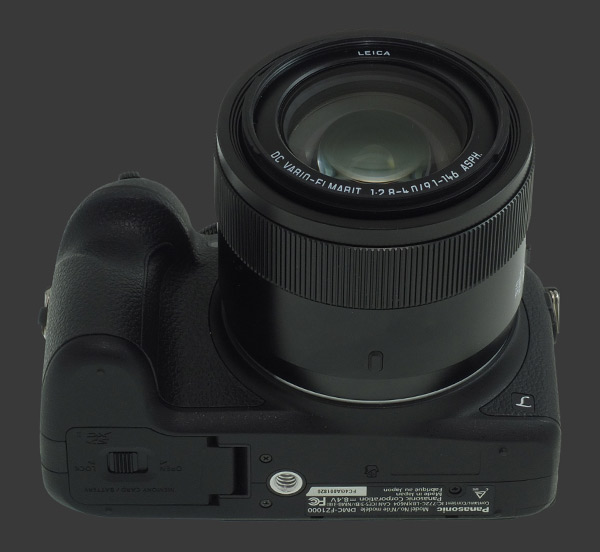
The bottom of the camera reveals a combined battery and memory compartment plus a metal tripod mount. The tripod mount is neither in-line with the optical center of the lens nor the center of gravity of the camera, making it less than ideal for usual tasks.
Handing of the Panasonic Lumix DMC-FZ1000 is among the top of its class. All the most important function are accessible without entering the menu system and the buttons are easy to press with good clicking response. Dials have firm detents to prevent accidental changes. The modal interface to set EC is the only annoyance.
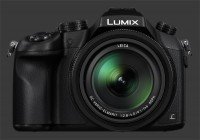 |
Please Support Neocamera
All information on Neocamera is provided free of charge yet running this website is a huge endeavor. Purchases made via affiliate links found throughout the site help keep it running and up-to-date. There is no additional cost to you, so please consider buying via these links to our affilates:
If you found any information on this site valuable and did not purchase via our affiliate links, please considering donating via PayPal:
Any amount will be greatly appreaciated. Thank you for your support!
Panasonic DMC-FZ1000 Highlights

Sensor-Size: 13 x 9mm

Actual size when viewed at 100 DPI
| 20 Megapixels Ultra Zoom | ISO 80-25600 |
| 16X Ultra-Wide Optical Zoom | Shutter 1/16000-60s |
| Built-in Stabilization | Full manual controls, including Manual Focus |
| 0.39" Built-in EVF 2.4 Megapixels (0.70X) | Custom white-balance with 2 axis fine-tuning |
| Automatic Eye-Start sensor | Spot-Metering |
| 2 Axis Digital Level | Hot-Shoe |
| 12 FPS Drive, Unlimited Images | Stereo audio input |
| 3840x2160 @ 30 FPS Video Recording | Lithium-Ion Battery |
| 3" LCD 920K Pixels | Secure Digital Extended Capacity |
Updates
2025.01.18

Fujifilm GFX 2025 Lens Roundup
Lens Review roundup of Fujifilm GFX Medium-Format lenses. Quality, performance and handling of the GF20-35mm F/4R WR, GF30mm F/3.5 Tilt-Shift and the GF55mm F/1.7.
2024.11.18

Best 2024 Photography Gifts for Every Budget
Great gifts for photographers and photo enthusiasts selected for every budget among the best products of 2024.
2024.08.07

Eye Protection Tips for Professional Photographers
The four main considerations for professional photographers regarding eyewear.
2024.07.14

Fujifilm X100VI Review
Flagship fixed-lens compact digital camera with a 40 MP sensor and Image-Stabilization, a first for the series. Retro design featuring dual control-dials, plus direct ISO, Shutter-Speed and EC dials. Its hybrid viewfinder can switch between EVF and OVF mode.
2024.05.09

Fujifilm GFX100 II Review
Flagship 102 Megapixels Medium-Format Mirrorless Digital Camera with 8-Stop 5-Axis IBIS, 8 FPS Drive, 8K Video and 400 MP Super-Resolution capture in a weatherproof and freezeproof body with dual control-dials and dual memory-card slots.
2024.04.03

Fujifilm X-T5 Review
Newest Fujifilm flagship boasting a 40 MP APS-C sensor, 5-axis IBIS with 7-stop efficiency, 15 FPS continuous drive, 6.2K Video capture, dual control-dials and dual SDXC UHS-II slots in a sturdy weatherproof and freezeproof body.
2023.11.20

Best Digital Cameras of 2023
Find out which are the Best Digital Cameras of 2023. All the new Mirrorless Digital Cameras from entry-level to high-end professional.
2023.07.10

Fujifilm X-H2 Review
40 Megapixels APS-C Hybrid Mirrorless Digital Camera with 7-stop IBIS. Fastest shutter ever and 8K video capture. Large builtin EVF with 0.8X magnification and 5.8 MP, plus an Eye-Start Sensor. Packed with features and large number of controls in a weatherproof and freezeproof body.
2023.05.07

Sony FE 20-70mm F/4G Review
Review of the unique Sony FE 20-70mm F/4G lens. The optical zoom of this lens spans ultra-wide-angle and medium focal-length coverage, making it one of the most versatile Full-Frame lenses on the market.
2023.01.15

Huion Inspiroy Dial 2 Review
Review of the Huion Inspiroy Dial 2 tablet, a medium sized drawing surface with dual dials and customizable buttons. Connects via USB-C or Bluetooth 5.0 with Windows, Linux and Android support.
2022.12.08

How to Pack for a Photo Trip
Find out how to pack for a travel photography trip, carry your gear safely while meeting airline regulations.
2022.11.13

Best Digital Cameras of 2022
The best digital cameras of 2022. A short list of the most outstanding models in their respective categories. Choose one for yourself or as a gift.














